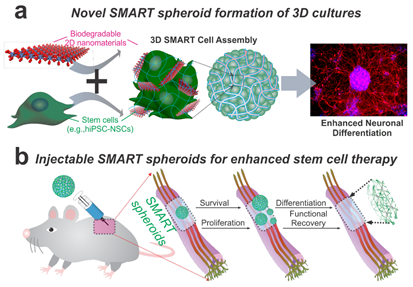
A. Schematic diagram showing the self-assembly of a spheroid.
B. Schematic showing transplantation of spheroids for the repair/regeneration of spinal cord
Invention Summary:
3D cell culture including organoid and spheroid cultures is at the center stage of biomedical research. It is widely applied in organ development research, disease modeling, drug screening and cell therapies. Conventional methods for 3D cultures using hydrogels, polymeric scaffolds, and nanofiber-based scaffolds or through scaffold-free approaches are utilized but they can be very time consuming.
Rutgers researchers have developed a novel method for rapid spheroid assembly using a biodegradable synthetic matrix. This specifically designed matrix nanomaterial functions as a scaffold for facilitating self-assembly of single cells into scaffold-cell spheroids. This system has the capability of integrating cell-matrix interactions and drug delivery vehicles into a spheroid-based cellular therapy platform. Pilot studies using human iPSC-derived neural stem cells-based 3D spheroids have shown the utility of this approach to treat spinal cord injuries in animal models.
Advantages:
- Platform technology – works on variety of cell types including neural stem cells, mesenchymal stem cells, iPSCs
- Fast – spheroid formation within minutes
- High cellular viability
- Tunable size control of assembled spheroids
Market Applications:
- 3D cell culture – spheroids and organoids
- Drug delivery
- Cell transplantation therapy
Intellectual Property & Development Status: Patent pending. Available for licensing and/or research collaboration.